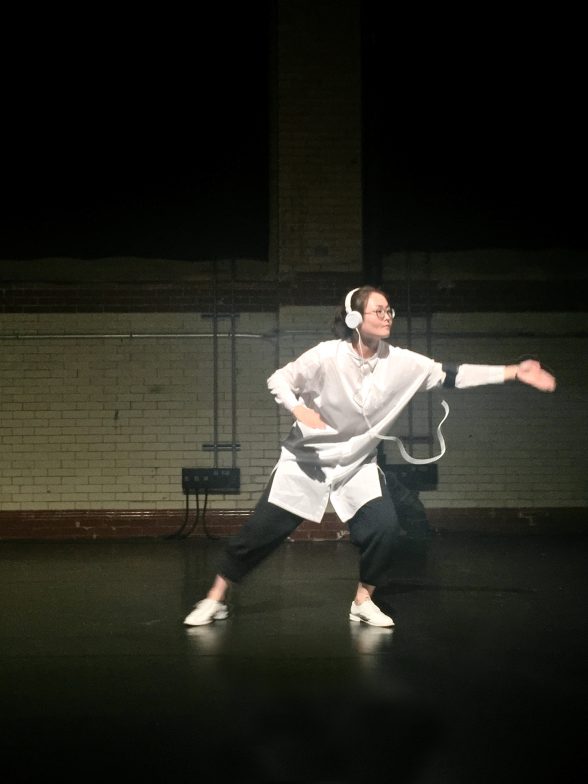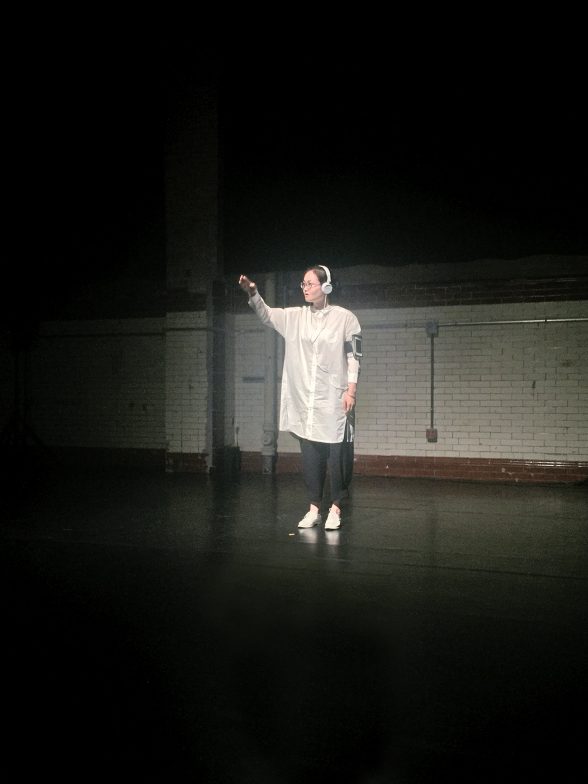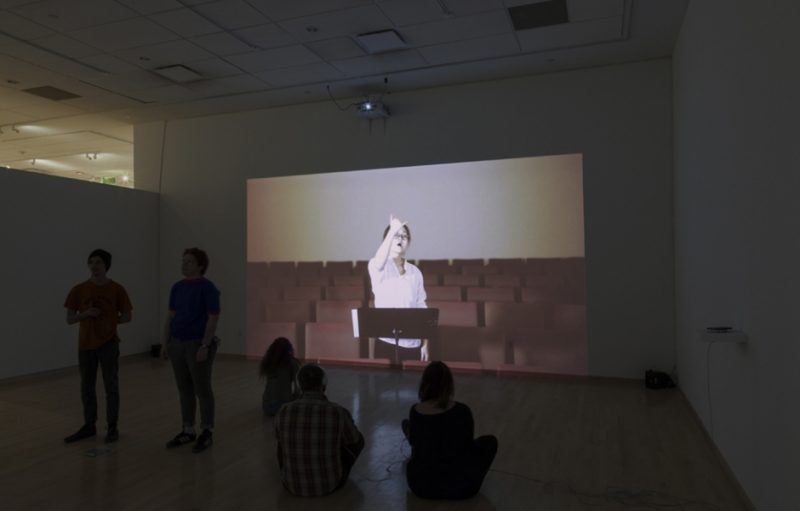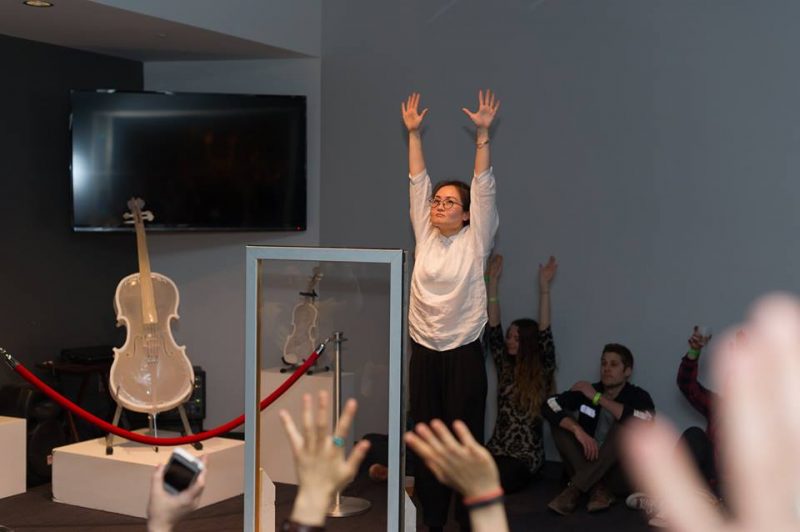Yixuan Pan is a Chinese-born artist currently based in Philadelphia. After business hours, when she works as a conservationist for the Philadelphia Museum of Art, she spends her time exhibiting, performing and developing a deeper understanding of the western world through the creation of her artwork. Her “anti-disciplinary” practice especially focuses on the idea of translation to expose the inevitable misunderstandings that emerge from countless forms of communication. In her most recent performance, “Conductible,” which premiered on Monday, May 7 at FringeArts Scratch Night, Pan listens to music through headphones while using her own body gestures and movements to translate what she hears to the audience. The result is a wistfully poetic – nearly silent – dance, which viewers are allowed to interpret for themselves.

Maddie: Seeing your performance at FringeArts, I was struck by the overlapping themes and disciplines you were tapping into, from music theory and composition to storytelling, translation and interpretative dance. Do you consider these to be implicitly or explicitly a part of your performance?
Pan: Since being a kid, I’ve always had broad interests. I did various dances (folk, ballet, contemporary), played several instruments (piano, bamboo flute, ukulele), went to private vocal classes, and calligraphy classes, loved training for Math Olympics—it’s been fun learning about new things, but it’s not easy to accept that I’m not professional at any of those things. Luckily, as an artist, my practice offered me a space to accept my passions and lack of knowledge on different subjects.
I would rather use “anti-disciplinary” than “Interdisciplinary” to describe my creative process. Rationalizing and categorizing the knowledge system is quite a western epistemological approach. I am extremely interested in the relationships across disciplines. However, I don’t usually start from a fixed medium, instead I start from my wonders/questions, and try to find suitable ways to talk about them.
M: You use humor and absurdity in a lot of your work, however in this performance you seemed much more serious, as though you were really attempting to translate a particular message. What were some of the thoughts you had while performing? While planning?
Pan: I do believe that seriously believing in translation (no matter if it’s from English to Chinese, from a piece of music to body language, or from one’s words to another’s interpretation) is very absurd. In my performance, I was trying as hard as I could to genuinely translate the music from my headphone to the audience, through my body language. Meanwhile, I was wondering how humorous a conductor who conducts no musicians would be. Is she still a conductor? Or is she a monologue performer, a forsaken governor, a permitted music describer? Through the conductor’s body, what is on the other side of the translation?
M: What inspired your movements and gestures for this performance?
Pan: I was thinking about the physical being of music. What is its weight? Texture? Color? Temperature? What kind of body language do people use to describe such subjective yet inter-personal experiences. I’ve been doing various research, for example, taking note of people’s hand gestures while they are talking.

M: It looked like you were carving the sound you heard in your headphones, with the outline of your shapes being determined by an imagined music notation. What are the parameters you use for translating music?
Pan: This is a very good question. I don’t have parameters yet, so it was all subjective translation. In fact, in my current residency (Lighthouse Works), I originally proposed to develop an index/dictionary. However, now I am starting to question if it’s necessary to rationalize this arbitrary mythology, when language is subjective already.
M: Interesting. What caused you to question this notion?
Pan: Maybe those “how to” videos on Youtube. I watch a lot of them! What is fascinating to me is that people desire formulas of doing things, and they believe there are such formulas for everything!
M: One of my favorite things about your work is the way you take a creative and poetic attitude towards learning something new. Can you speak more to that?
Pan: As I mentioned before, art making offers me opportunities to play with things that I’m not an expert at. For example, I went to Tyler’s glass MFA program before I ever blew glass. I do feel vulnerable when I touch the unfamiliar, but I try to let my curiosity and “not-taking-things-for-granted” attitude lead me to fruitful grounds.

M: Of course, and your approach to using glass is rather unique. How do you view glass as a medium?
Pan: I think Glass is not a symbol for translation. Glass is translation. Here is something I wrote before: “Glass is fuzzy, yet sharp. It is some metaphysical lens I look through. I use the inherent linguistic properties of glass to echo the liberty and untranslatability of our semantic struggles. Through poetry, writing, swimming pool exercising, lollipop making, soap bubble blowing, music therapy operating, glass shards foraging, recording, love letter whispering, choral singing conducting, and unfamiliar situations curating—I address the physical experience of another language, the impossibility to truly externalize human feelings that exceed verbal language, and the meanings and aesthetics of certain sonic performances.”
M: How do you think about objects in relation to your performance?”
Pan: I really try to edit the objects in my performance. How can they be activated in my performance? Every object has its historical and social context, and those could be unnecessary or surprisingly fruitful for the piece.
M: Can you talk a little about the importance of audience participation in your work?
Pan: My work needs the audience to complete it. I agree with Fluxus that artwork needs the audience to complete it (although they often set up rules, so-called “scores,” to control the directions of their pieces). First of all, my work usually relies on people’s intellectual participation rather than their physical participation. Secondly, I don’t set up rules for the audience, directly telling them how to interact with or how to experience it. Instead, I design the situation, edit information, and let them autonomously respond to it. So my work is being completed in the viewer’s minds.

M: I interpreted your role as a conductor, which is something you’ve explored before in other work. Can you speak to the inclusion of music in your performances?
Pan: I think about sound as sculpture, as a crucial aspect of any experience. Sometimes it happens to be music—as a pre-existing art form with its own history and context—and sometimes it’s just everyday noise that I wish to bring more light to.
M: While performing, do you believe yourself to be a conductor with an audience of musicians, or are you a composer with an audience of listeners?
Pan: I think the audience is both! I was trying to emphasize the blurry line between the two roles by knocking down? the 4th wall of acting—I directly stare at individual audience member’s eyes. Therefore, they are musicians (but with no instruments), and they are music receivers, but they are not just a passive theater audience.
M: Do you think of art and movement as a universal language?
Pan: I don’t think there is such a thing as a “universal language.” I don’t think one language can communicate all human beings. Yes, we all experience something from art and body movements, but it’s unlikely we are getting the same thing, as it is unlikely that the audience gets what the artist wants to talk about precisely.
To find out more about Pan’s past and upcoming projects, visit her artist website and listen to her podcast interview with Matt Kalasky.





